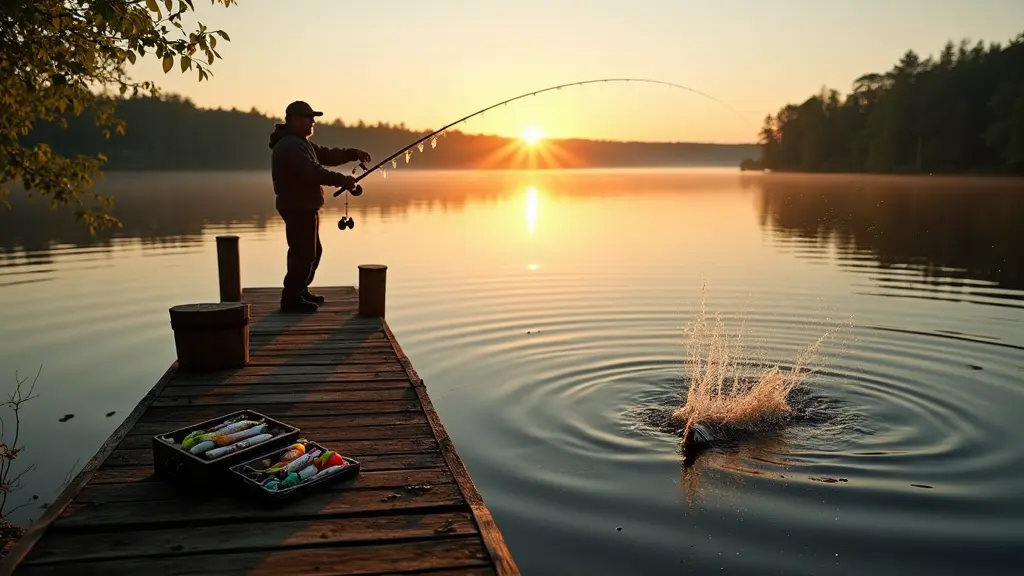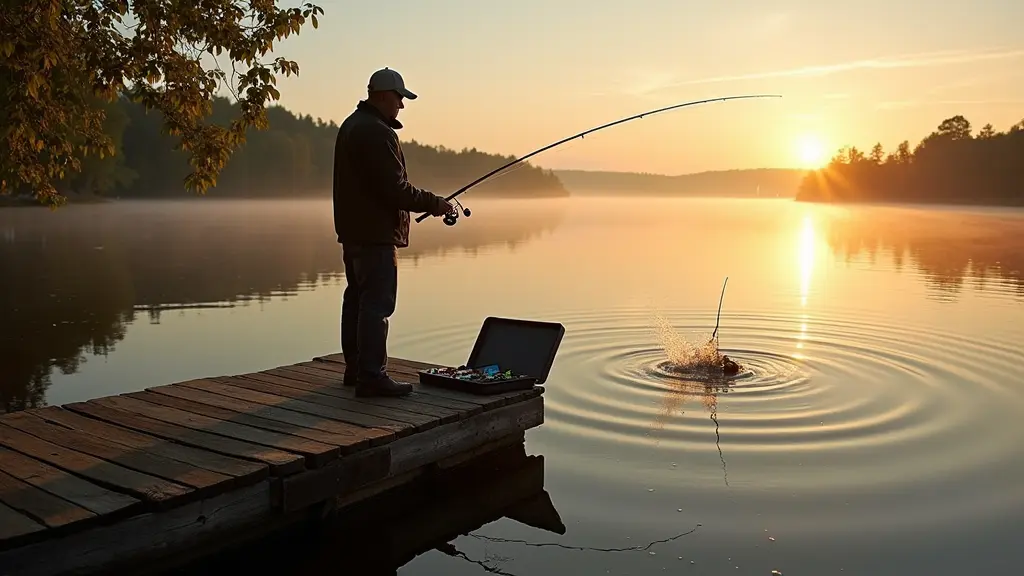Bass Fishing Lures for Lakes and Rivers

As anglers, we’re always on the lookout for that elusive lunker, and the secret to reeling it in often lies in the right choice of lure. Whether you’re fishing serene lakes or winding rivers, a well-selected lure can make all the difference between a mediocre catch and a trophy-sized bass.
Bass Lure Selection
Lures come in a wide range of shapes, sizes, and materials, each designed to mimic the natural prey of bass.
For instance, a spinnerbait can be effective in open water, while a soft plastic can be used in structure-rich areas. A swimbait can be a game-changer in rivers, as it closely mimics a injured baitfish and can be retrieved at a pace that allows the fish to attack it naturally.
What Lures to Choose for Lake Bass
The thrill of reeling in a lake bass is a feeling like no other, but it’s not just about luck – it’s about understanding the habits and habitats of these finicky fish. Understanding your target species is the first step in choosing the perfect lure, as largemouth, smallmouth, and hybrid bass each have distinct preferences when it comes to habitat and prey.
Familiarizing yourself with the water conditions you’ll be fishing in is also crucial.
Suspender bass tend to thrive in clearer waters with a slower sink rate, while fast sink creatures like largemouth bass can be found in murkier waters.
A rubber worm can be an effective lure in these clearer waters, as it mimics the natural movement of a worm.
To ensure a successful trip, consider the environment you’ll be fishing in. Rivers and lakes each have unique properties that respond differently to presentations of a rubber worm, spinner lure, diver, suspender, rattle, slow sink, and fast sink as well as weighted lures.

Why Use Curly Tail Lures
Fishing enthusiasts are always on the lookout for new and effective ways to reel in the big catches, and one underappreciated strategy is using curly tail lures in combination with a slow retrieve speed.
I. Introduction to Curly Tail Lures
A curly tail lure is a type of fishing lure that features a curly or scissor-like tail attached to the back of the lure, which creates a unique movement and action in the water.
Curly tail lures have a rich history, dating back to the early 20th century when they were first introduced as a bass fishing lure.
II. Advantages of Using Curly Tail Lures
One of the primary advantages of using curly tail lures is their unique movement and action in the water, which attracts fish with irresistible movement patterns at various retrieve speeds, including slow retrieve, fast retrieve, pause, and pause duration, all while effectively presenting the hook and size, and being mindful of the lure’s shape.
How Fast to Retrieve Spinnerbaits
When you’re on the water, nothing beats the thrill of reeling in a bass using a well-crafted spinnerbait. The success of this technique hinges on the subtle art of retrieval speed, which can make all the difference in enticing a bite.
Understanding the factors that affect spinnerbait retrieval speed is crucial for any angler looking to optimize their fishing experience.
The material used to construct the spinnerbait, for instance, plays a significant role, with many manufacturers offering different options to suit various water conditions and fishing styles.
A spinnerbait with a bright color finish may be more effective in murky waters, while a lure with a more subtle texture may be better suited for clear waters. The texture of the spinnerbait’s skirt, in particular, can greatly influence the way it moves through the water, making it more attractive to fish.
Which Lures for Weed Bed Bass
Mastering the art of bass fishing in weed beds is a true test of skill, patience, and knowledge of the water’s dynamics. Fishing in these complex structures requires a deep understanding of the terrain, texture, and movement of the water, which can greatly impact the choice of tackle and lure selection.
Fishing for bass in weed beds is a challenging yet rewarding experience that requires a deep understanding of the dynamics involved.
This type of fishing requires patience, skill, and the right equipment to successfully target bass hiding among vegetation.
We’ll explore the importance of understanding weed bed structure and depth, and discuss the types of weed beds and their characteristics.
When it comes to selecting the right weed bed bass lures, understanding the movement and action of the water is crucial. For instance, when navigating a slow-moving water with dense vegetation, a weedless lure with a braided line leader length of at least three feet and a floatation rigging system.
Whats the Best Crankbait Retrieve
As the water flows across the river’s surface, it creates a subtle dance of dynamics that can make or break a fisherman’s day. This intricate ballet of buoyancy and water current sets the stage for a crucial element in crankbait fishing: the retrieve.
Defining the Role of Retrieve
In crankbait fishing, the retrieve is the movement of the lure through the water, which plays a vital role in attracting and catching fish.
Understanding the importance of retrieve is essential for effective crankbait use, as it can make a significant difference in the outcome of a fishing trip.
Factors Influencing the Retrieve
Water temperature and its impact on baitfish activity can greatly influence the retrieve. As water temperature changes, baitfish behavior also changes, requiring anglers to adjust their retrieve accordingly.
What Makes a Good Jig Presentation
Beneath the surface of recreational fishing lies a world of subtlety and precision, where the slightest misstep can mean the difference between a hooked trophy and a blank reel. Amidst the thrill of the chase, mastering the art of presentation can make all the difference in reeling in a prized catch.
Fishing for bass requires precision and finesse, and a good jig presentation is crucial to reeling in a catch.
By understanding the intricacies of the presentation, anglers can increase their chances of landing a trophy-sized bass.
In introducing the concept of jig presentation, it’s essential to define what it means and why it matters in bass fishing. Simply put, jig presentation refers to the way a jig moves through the water, its visibility, and how it interacts with the surrounding environment. make or break the outcome of recreational and competitive fishing.
Key Aspects of Jig Presentation in Bass Fishing
- The slightest misstep in jig presentation can mean the difference between a hooked trophy and a blank reel.
- Mastering the art of presentation can make all the difference in reeling in a prized catch, especially in bass fishing.
- A good jig presentation is crucial to reeling in a catch, as it requires precision and finesse.
- Understanding the intricacies of jig presentation can increase an angler’s chances of landing a trophy-sized bass.
How to Fish Suspending Lures
Freshwater fishing demands finesse, and nowhere is this more evident than in the art of presenting lures that suspend just beneath the surface. With these subtle baits, anglers must carefully manipulate the lure’s buoyancy to mimic the natural movements of injured baitfish, weeds, or other obstacles that predators use as ambush points to snag unsuspecting prey.
Strongly correlated with the success of suspended lures is the choice of professional fishing spots, where structure, cover, and transitions between different fishing grounds can prove irresistible to hungry fish.
Which Lures for River Lunker Bass
As the majestic flow of rivers carves their paths through landscapes, it’s essential to recognize the intricate relationships between the water’s movements and the bass that thrive within them. Finding the right lure for river lunker bass requires a profound understanding of the fish’s behavior and the habitats that shape their actions.
Fishing zones are a crucial aspect of successful river bass fishing, as they often dictate the types of lures that are most effective.
How to decipher the subtle signals that reveal the presence of lunker bass by identifying fishing zones, fishing regions, fishing destinations, fishing expeditions, aquatic environments, fishing principles, and fishing practices that align with tried and true fishing guidelines.
Understanding River Bass Fishing
- River bass are attracted to structures such as rocks, weed beds, and sunken logs, which provide shelter and food.
- The water’s clarity, temperature, and flow rate can significantly impact the behavior and movement of lunker bass.
- Fishing zones can be identified by looking for areas with a high concentration of baitfish, such as schools of shad or minnows.
- Using the right lure and presentation is crucial in river bass fishing, as it can make the difference between catching a small bass and a lunker.


